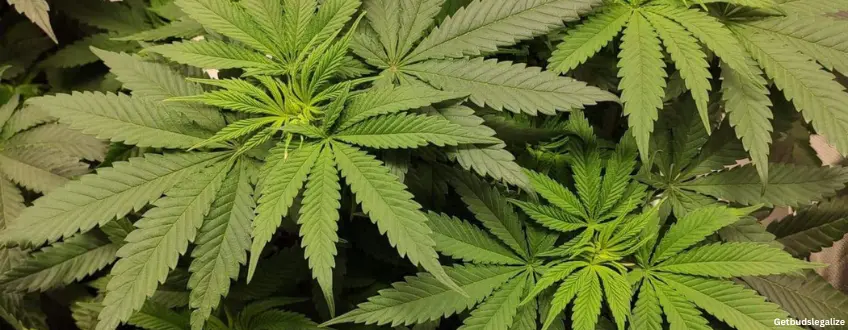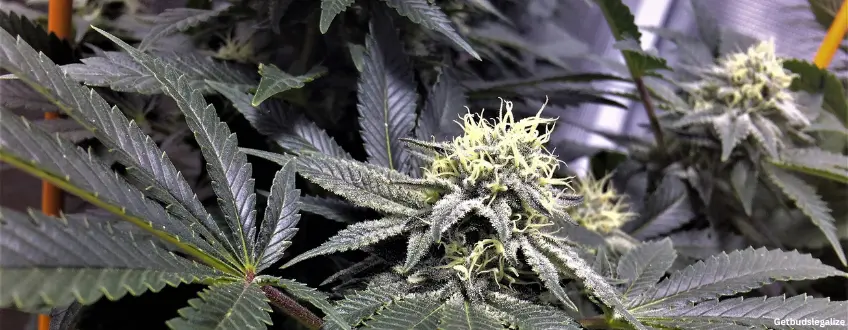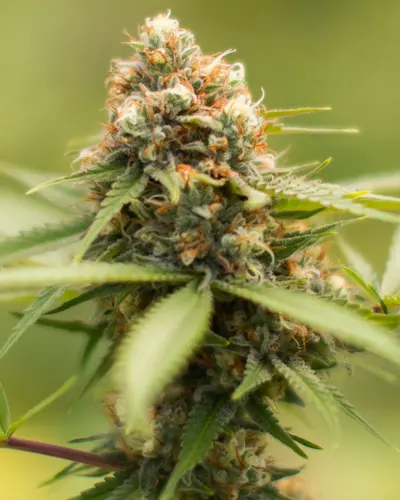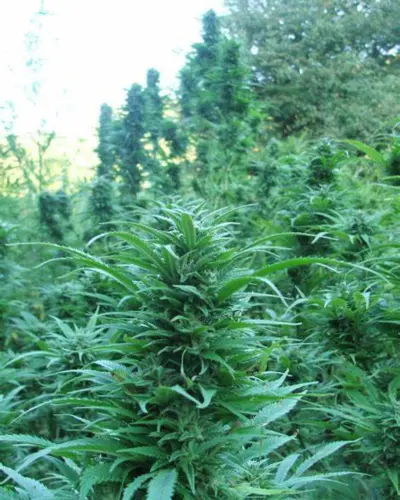Durban Poison Strain Review & Growing Guide
Durban Poison has rightfully earned its esteemed reputation as one of the most coveted Sativa strains available today. Originating from the vibrant port town of Durban in South Africa, this African gem embodies the essence of a good time and delivers an unparalleled cannabis experience.
Renowned for its intense yet clean euphoric high, this strain of cannabis guarantees an upbeat journey filled with laughter and positive vibes. It’s the perfect companion for those looking to maintain an energetic and uplifted mood throughout a busy day of tackling tasks and responsibilities.
One of the standout features of this strain is the supreme sweetness of its buds, offering a savory and aromatic smoking experience that is truly a delight for the senses. But Durban Poison is not just about pleasure; it also packs a potent punch with potentially high THC levels, distinguishing it from other pure Sativa strains.
Durban Poison Strain Effects
The Durban Poison strain is renowned for its powerful cerebral effects, characterized by a clear-headed effect and a rush of creativity and energy. Its uplifting and stimulating properties make it a popular choice among those in creative professions or anyone looking for a boost in motivation and concentration.
Additionally, its ability to improve mood and induce happy euphoria can help enhance various activities, whether working on art projects, engaging in outdoor adventures, or simply enjoying social interactions. Many users report feeling more curious and exploratory under its influence, which can lead to a greater appreciation for their surroundings and experiences.
Additionally, Durban Poison is often praised for its ability to provide a stimulating effect without the jittery side effects commonly associated with caffeine, making it an attractive alternative for those looking to start their day or maintain productivity without feeling overly jittery.

Durban Poison Terpenes
Durban Poison is renowned for its unique and vibrant terpene profile that contributes to its distinctive aroma and potential therapeutic effects. Terpenes, the aromatic compounds found in many plants, are responsible for the diverse scents and flavors of cannabis strains. They also play a crucial role in influencing the overall experience of a strain, often enhancing its specific properties.
Dominant terpene:
| Terpene | Characteristics |
| Terpinolene | Fresh, smoky, wood, herbal, citrus, floral |
The dominant terpene in Durban Poison is terpinolene, which presents a complex bouquet of fresh, smoky, woodsy, herbal, citrus, and floral notes. This multifaceted terpene is not only responsible for the strain’s refreshing aroma but is also associated with uplifting effects that may help stimulate creativity and focus.
Secondary terpenes:
| Terpene | Characteristics |
| B-Myrcene | Earthy, musky, fruity, clover |
| Ocimene | Herbal, sweet, citrus, herbaceous, wood |
| β-Pinene | Dill, parsley, basil, hops, wood, pine |
| Caryophyllene | Spicy, cinnamon, clover |
| Linalool | Floral, lavender, rose, citrus, wood, rosewood |
| Humulene | Hops, earthy, wood, herbal |
| D-Limonene | Citrus, lemon, orange, tangerine |
Accompanying terpinolene are secondary terpenes that add depth and complexity to the strain’s profile.
- B-Myrcene, known for its earthy and musky undertones, is often linked with relaxing properties that can potentially aid in reducing stress and tension.
- Ocimene, with its sweet and herbaceous fragrance, may contribute to the strain’s decongestant and anti-inflammatory qualities.
- β-Pinene offers a refreshing hint of dill, parsley, basil, hops, wood, and pine, which may help with alertness and memory retention.
- Caryophyllene, with its spicy and cinnamon-like aroma, is unique for its ability to interact with the body’s endocannabinoid system, potentially providing anti-inflammatory and analgesic benefits.
- Linalool, reminiscent of floral lavender and rose with a touch of citrus and wood, is often associated with calming effects that might aid in anxiety and stress relief.
- Humulene, which shares a similar scent profile with hops, carries earthy, woody, and herbal notes and may support anti-inflammatory and appetite-suppressing properties.
- Lastly, D-Limonene, as the name suggests, exudes a strong citrus scent, reminiscent of lemon, orange, and tangerine. This terpene is celebrated for its mood-enhancing and stress-relieving potential, adding a bright and zesty character to Durban Poison’s aroma.

Best Durban Poison Strains for Sale
Aroma & Flavor
Durban Poison is a cannabis strain with a distinct, sweet scent that sets it apart from other strains. Its aroma is robust and stimulating with pine nuances that enhance its fragrance. Along with its sweetness, Durban Poison has an earthy undertone that adds complexity to its flavor profile. The aroma and flavor of this variety are enriched with subtle spicy accents that balance the sweetness.
When smoked, Durban Poison offers a flavorful smoking experience that complements its flavor profile. The earthy notes give it a deep, herbaceous flavor, while the pine undertones keep it refreshing. As you exhale you will experience a pleasantly sweet and citrusy aftertaste that will remain on your palate.
Adverse Reactions
While Durban Poison offers a myriad of positive effects, it is essential to also be aware of its potential negative effects, especially for those who may be sensitive to strong Sativa strains.
One of the most commonly reported side effects, as with many cannabis strains, is dry mouth, often referred to as “cottonmouth.” This sensation can be alleviated by staying hydrated before, during, and after consuming the strain.
Additionally, some users may experience dry eyes, which may be accompanied by redness or irritation. Using over-the-counter eye drops can help relieve this discomfort.
Another potential drawback of this strain is its tendency to induce feelings of anxiety or paranoia in some individuals, particularly those prone to these conditions. This can be particularly problematic in social settings or high-stress environments, making it less than ideal for family gatherings or other similar events where maintaining a calm and relaxed demeanor is essential.
Finally, some consumers have reported experiencing mild headaches after consuming this strain. While this is not a universal side effect, it is worth pointing out for those who are thinking of trying this strain for the first time or increasing their dosage.
Medical Benefits
The therapeutic properties of Durban Poison have attracted attention for its potential to treat various mood-altering conditions and physical symptoms, making it a popular strain among medical cannabis users.
Its uplifting and mood-enhancing effects may be especially helpful for people who struggle with depression and anxiety. By promoting feelings of happiness and well-being, this strain can help alleviate the symptoms of these conditions and improve overall mental health.
In addition to its mood-enhancing properties, Durban Poison’s mild body high and energizing effects make it an effective stress reliever. It can help combat stress and fatigue associated with a busy or toxic lifestyle, providing users with a sense of relaxation without inducing drowsiness or lethargy.
Additionally, this strain has shown promise in relieving nausea, a common side effect of various medical treatments, including chemotherapy and radiation. For cancer patients undergoing these treatments, nausea can have a significant impact on quality of life and appetite.
By reducing nausea and migraines, Durban Poison can help restore appetite and improve nutritional intake, which is critical for maintaining strength and energy during cancer treatment.

Durban Poison Strain Grow Info
Durban Poison is generally considered to be moderately difficult to grow. However, with attention to detail and adherence to its specific requirements, both novice and experienced growers can achieve impressive results.
Indoor vs. Outdoor Cultivation:
- Indoor Cultivation: Durban Poison can be effectively cultivated indoors, with hydroponic systems being particularly suitable. It’s essential to ensure adequate vertical space to accommodate its tall stature. Employing training techniques can help manage the height and optimize space utilization. Proper ventilation and humidity control are also crucial factors to consider.
- Outdoor Cultivation: Durban Poison thrives when cultivated outdoors, especially in temperate and sunny climates. It can reach towering heights of up to 90 inches (approximately 7.5 feet) when given ample space to grow. Ensure the plants receive plenty of sunlight and provide support, such as trellising, to help manage their vigorous growth.
Climate Requirements:
Durban Poison is adaptable to various climates, but it performs best in temperatures ranging from 65 to 85 degrees Fahrenheit. It is resilient to different weather conditions, making it suitable for cultivation in a wide range of outdoor environments.
Grow Techniques:
- Pruning: Regular pruning is essential to focus its energy on the main bud sites and improve airflow and light penetration. This can help prevent issues like mold and mildew and promote healthier, more robust growth.
- Training: Techniques such as topping, low-stress training (LST), and scrogging can be used to manage Durban Poison’s height and encourage lateral growth, leading to increased yields.
Feeding:
- Nutrients: Durban Poison prefers a lighter nutrient regimen, especially during the vegetative stage. Be cautious with nitrogen levels to avoid nitrogen toxicity. A balanced fertilizer with higher levels of phosphorus and potassium during flowering can help support bud development.
- Supplements: Consider using silica supplements to strengthen Durban Poison’s stems, which can become tall and lanky. This will help support the weight of its large buds and prevent breakage.
Durban Poison Flowering Time
Indoors
When grown indoors, Durban Poison, with a 100% sativa genetic makeup, has an average flowering time of approximately 9 weeks. During this period, it’s crucial to provide the plant with the right conditions, including proper lighting, nutrients, and temperature control, to ensure optimal growth and development.
Outdoors
For outdoor cultivation, Durban Poison typically begins flowering in the late summer and is usually ready for harvest around late September to early October. The exact timing can vary depending on specific environmental factors and the geographic location of the cultivation site.
Outdoor growers should monitor their plants closely as they approach maturity to determine the optimal harvest time based on the plant’s trichome development and overall bud maturity.

Durban Poison Yield
When cultivated indoors, Durban Poison typically yields around 13 ounces per square meter. However, in outdoor settings, where the plant has more space and access to natural sunlight, it has the potential to produce even higher yields, averaging around 16 ounces per plant.
Durban Poison Strain History
Durban Poison has a rich and captivating history that originates from the coastal city of Durban in South Africa. This renowned sativa strain gained international recognition when it was discovered by an American cannabis activist during their travels to South Africa in the 1970s. Intrigued by its distinct aroma, flavor, and potent effects, the activist recognized the unique potential of Durban Poison and decided to bring it back to the United States.
Upon its introduction to the American cannabis scene, Durban Poison quickly garnered attention for its uplifting and energizing effects, as well as its robust growth characteristics. Its popularity grew steadily, and it soon became a staple among cannabis enthusiasts and breeders alike.
Over the years, Durban Poison has been used to create numerous hybrid strains, thanks to its desirable traits and stable genetics. Despite its global popularity and widespread cultivation, Durban Poison has managed to maintain its authentic African roots and unique characteristics, making it a beloved choice among connoisseurs seeking a pure sativa experience.
FAQs about Durban Poison Marijuana Strain
This strain of cannabis is known for its generous yields, especially when grown outdoors. Here’s a summary of the yield you can expect from this strain:
- Indoors: Approximately 13 ounces per square meter.
- Outdoors: An average of 16 ounces or more per plant.
It’s important to note that these are average yields, and actual yields can vary based on a variety of factors such as growing conditions, cultivation methods, and environmental factors. With proper care and optimal growing conditions, growers may be able to achieve yields that exceed these averages.
Durban Poison typically has a THC content ranging from 16% to 20%. This level of THC makes it a moderately potent strain, offering users a balanced and uplifting experience without overwhelming psychoactive effects when consumed responsibly. As with any cannabis strain, the actual THC content can vary based on growing conditions, cultivation techniques, and other factors.
The Durban Poison weed is known for producing a range of uplifting and energizing effects. Below are the main effects commonly linked with this strain:
- Uplifted Mood: Durban Poison has the potential to elevate mood, instilling a sense of happiness and overall well-being in users.
- Increased Energy: Many consumers report feeling energized and revitalized after using it, making it an attractive option for daytime drinking.
- Feelings of Happiness: This strain frequently induces feelings of joy and contentment, contributing to its popularity among users seeking mood enhancement.
- Profound Euphoria: consuming this strain can induce a deep sense of euphoria, amplifying mood and fostering a positive mindset.
- Enhanced Creativity: A significant number of users find that Durban Poison stimulates creativity and focus, making it a preferred choice among artists and individuals in creative fields.
It’s important to note that the specific effects experienced can vary from person to person based on individual tolerance, dosage, and other factors.
Growing Durban Poison plant can be a fulfilling experience, given its unique traits and robust growth potential. Here’s a detailed guide to help you successfully cultivate Durban Poison:
Grow Difficulty:
- Durban Poison is generally considered to be of moderate growth difficulty. With the right care and attention to its specific needs, both novice and experienced growers can achieve impressive results.
Indoor vs Outdoor Cultivation:
- This strain of cannabis adapts well to various cultivation environments, making it suitable for both indoor and outdoor growing.
Outdoor Cultivation:
- Durban Poison thrives when cultivated outdoors in nutrient-rich soil. Given its sativa genetics, it can grow tall, reaching heights of up to 90 inches (approximately 7.5 feet).
- To support its expansive growth and heavy buds during the flowering stage, it’s crucial to provide ample trellising or stakes for structural support.
Climate Requirements:
- Durban Poison is versatile and can tolerate a range of climates. However, it thrives best in temperatures between 65 and 85 degrees Fahrenheit.
- While it is resilient to varying weather conditions, providing a stable and favorable environment will promote healthier and more vigorous growth.
Grow Techniques:
- Pruning: To optimize the yield and quality of Durban Poison buds, it’s beneficial to prune the plant aggressively. This helps redirect its energy towards the main bud sites that receive the most sunlight, promoting better airflow and light penetration.
Feeding:
- When feeding this strain, it’s advisable to use a balanced nutrient regimen, but go lighter on nitrogen to avoid nitrogen burn.
- Monitor the plants closely for any signs of nutrient deficiencies or excesses and adjust the feeding regimen accordingly.
Supplements:
- Consider integrating silica supplements into the feeding regimen. Silica supplements can strengthen the tall and slender stems characteristic of this strain.
Harvesting:
- Durban Poison typically has a flowering time of approximately 9 weeks when grown indoors. Outdoor cultivation usually results in a harvest window around late September to early October.
- Monitor the trichome development and overall maturity of the buds to determine the optimal harvest time for the desired effects and potency.
In conclusion, growing Durban Poison can be a rewarding endeavor for growers of all levels. By providing the right growing conditions, proper care, and attention to detail, you can cultivate robust and high-quality plants that showcase their unique characteristics, potent effects, and delightful aroma and flavor profile.
Durban Poison is a pure Sativa strain, with a genetic makeup of 100% Sativa.
Durban Poison offers a pleasing blend of earthy, pine, sweet, citrus, and herbal tastes. The earthy and pine elements impart a woody and grounded flavor, complemented by the fruity tang of sweetness and citrus. Additionally, the herbal notes contribute a refreshing and revitalizing aspect to the overall taste.
Durban Poison is known for its natural resilience against mold and pests. It tends to be more resistant compared to some other cannabis strains, making it a favorable choice for cultivation in various conditions. However, it’s essential to maintain proper growing practices and environmental conditions to maximize its resistance and overall health.
Durban Poison is often sought after for its potential medical benefits. Here are some of the commonly reported therapeutic effects and conditions it may help alleviate:
- Stress: This strain is known for its uplifting and energizing effects, which can help combat stress and promote a more relaxed state of mind.
- Depression: The mood-enhancing properties of Durban Poison may provide relief for individuals experiencing symptoms of depression, offering a brighter and more positive outlook.
- Pain: Some users report that this strain of cannabis can help alleviate various types of pain, including chronic pain, due to its potential analgesic properties.
- Fatigue: The energizing and invigorating effects of Durban Poison can help combat fatigue and boost energy levels, making it a popular choice for daytime use.
- Nausea: This strain may also offer relief from nausea and gastrointestinal discomfort, making it potentially beneficial for individuals undergoing chemotherapy or experiencing other medical conditions that cause nausea.
It’s important to note that while many users report positive effects from using this strain for these medical conditions, individual experiences can vary. As with any medicinal substance, it’s advisable to consult with a healthcare professional before using Durban Poison for therapeutic purposes.
When using the Durban Poison, some individuals may experience certain adverse reactions. Here are the potential side effects associated with this strain:
- Dry Mouth: Also known as cottonmouth, this is a common side effect of many cannabis strains, including Durban Poison. It can leave users feeling thirsty and with a dry sensation in the mouth.
- Dry Eyes: Like dry mouth, certain users may encounter dry and irritated eyes when consuming this strain. This can result in redness, itchiness, and a feeling of discomfort.
- Anxious: Despite its uplifting properties, this strain can sometimes induce feelings of anxiety or nervousness in some users, especially those sensitive to THC.
- Paranoid: In some cases, the psychoactive effects of Durban Poison may exacerbate feelings of paranoia or heightened anxiety.
- Headache: While relatively rare, some individuals may experience headaches as a side effect.
It’s important to remember that the severity and occurrence of these side effects can vary from person to person. Factors such as dosage, individual tolerance, and consumption method can also influence the likelihood and intensity of these adverse reactions. As always, it’s recommended to consume cannabis responsibly and be mindful of your body’s response to avoid or mitigate any negative side effects.
Durban Poison Strain Info:
Characteristics:
- Genetics: Pure South African Sativa
- Variety: Sativa 100%
- Sex: Feminized seeds
- THC: 16% to 20%
- CBD: 0.02%
- CBG: 1%
- Climate: Temperate to sunny climates, away from frost
- Difficulty: Easy to grow
- Yield: indoor 13 ounces/m2, outdoors 16 ounces/plant
- Flowering: Indoor 9 weeks, Outdoor late September to early October
- Taste & Smell: Earthy, pine, spicy, sweet, citrus, herbal
- Effect: Uplifted, energetic, happy, euphoric, creative
- Medical uses: Stress, depression, pain, fatigue, nausea

These Are Some Other Popular Strains That You Might Enjoy:


ILGM Fertilizer

- From seedling to harvest, give your plants everything they need.
- Enough for feeding at least 5 plants.
- Discounted Package Deal
- Works well in soil, hydroponics, and other growing mediums.
- The best way to treat your plants
ILGM Plant Protector

- Protect your cannabis from diseases and harmful pests.
- Contains three 20 ml bottles.
- Enough supplies to protect 20 plants.
- It can be used in soil, hydroponic, and all other growing mediums.























